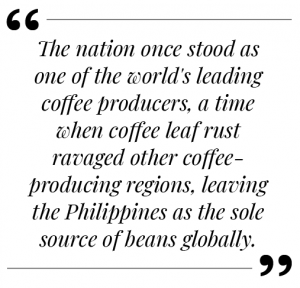By Brian James Lu
 IN THE vibrant ambiance of coffee shops during my frequent meetings, I’ve marveled at the sight of young professionals and students indulging in various coffee concoctions — espresso, black coffee, frappe, cappuccino, latte, and more.
IN THE vibrant ambiance of coffee shops during my frequent meetings, I’ve marveled at the sight of young professionals and students indulging in various coffee concoctions — espresso, black coffee, frappe, cappuccino, latte, and more.
It’s a captivating spectacle, witnessing these generations relishing brewed coffee in all its diverse forms.
Those who came of age in the ’70s fondly recall the robust barako as their brew of choice, with Nescafe being the sole instant coffee option.
Over the past two decades, coffee, once overlooked in the Philippines, has experienced a remarkable resurgence.
Renowned for its Robusta and Arabica varieties, Philippine coffee has not only gained recognition for its unique flavors but has also become a crucial source of livelihood for local farmers.
Coffee, the second most traded commodity globally after oil, boasts a rich history, with the Philippines standing as a top producer in the 1800s.
However, today, we predominantly import coffee, highlighting the need for a resurgence in local production.
The Philippines’ coffee cultivation dates back to the 18th century, during the Spanish colonial era. The nation once stood as one of the world’s leading coffee producers, a time when coffee leaf rust ravaged other coffee-producing regions, leaving the Philippines as the sole source of beans globally.
However, when the leaf rust reached our shores, almost all coffee trees were decimated, requiring considerable time for Filipinos to rejuvenate coffee tree cultivation.
Recent years have seen a renewed interest in Philippine coffee, with young entrepreneurs capitalizing on a generation enamored with brewed coffees. Local farmers and entrepreneurs are leading the charge to rejuvenate the industry, focusing on specialty coffee production.
With government assistance, farmers have embraced sustainable practices, enhancing bean quality and crafting unique flavor profiles that resonate with coffee enthusiasts worldwide.
The government’s commitment to revitalizing the coffee industry took a significant step with the institutionalization of the Philippine Coffee Industry Roadmap in 2017. The aim is to bridge gaps in the supply chain, fostering a globally competitive industry responsive to customers and beneficiaries.
Situated in the “Bean Belt,” the Philippines, with its tropical climate and diverse geography, is one of the few countries cultivating all four coffee species — Liberica, Excelsa, Robusta, and Arabica.
The famous barako, associated with Liberica, finds its roots in Batangas province during the Spanish period.
Across the country, locally brewed coffee, especially the traditional kettle, is often referred to as barako.
Arabica thrives in high-altitude areas, while Robusta excels in lower altitudes, offering a diverse range of coffee experiences to cater to various consumer preferences.
Key coffee-producing regions in the Philippines include:
–Benguet: Known for its Arabica beans, producing coffee with bright acidity and floral notes.
–Sagada: Another Arabica hub, characterized by mild acidity and fruity undertones.
–Mount Matutum: In Mindanao, this region produces high-quality Arabica beans with unique flavor profiles.
–Cavite and Batangas: Famous for Barako (Liberica) coffee and sprawling Robusta farms.
The revival of the Philippine coffee industry aligns with a commitment to sustainable farming practices. Many farmers have shifted to organic and shade-grown methods, not only improving coffee quality but also having positive environmental impacts, attracting environmentally conscious consumers.
Philippine coffee is not only gaining international recognition but is also finding favor locally. With more Filipinos developing a taste for specialty coffee, there is a growing market for premium homegrown beans.
Additionally, Philippine coffee has earned acclaim in international competitions, further boosting its reputation on the global stage.
Despite the industry’s resurgence, challenges persist, including infrastructure limitations, market access issues, and the looming threat of climate change affecting coffee production.
However, opportunities for growth abound, such as increasing export potential and expanding coffee tourism to showcase the unique origins of Philippine coffee.
In 2021, coffee imports surpassed local production, emphasizing the need to plant more coffee trees and improve post-harvest production. Enhancing harvesting and drying processes is crucial for sustained growth.
The journey of the Philippines’ coffee industry, from colonial beginnings to decline and now a renaissance, reflects a newfound focus on quality, sustainability, and local consumption.
The country’s diverse coffee-growing regions, unique flavor profiles, and commitment to sustainable practices position Philippine coffee to once again become a principal source globally. As it evolves and expands, Philippine coffee is poised to leave an indelible mark on the world’s coffee culture.
Editor’s note: The opinions expressed in the foregoing article are solely the author’s and do not reflect the opinions and beliefs of the Philippine News Agency (PNA) or any other office under the Presidential Communications Office.
